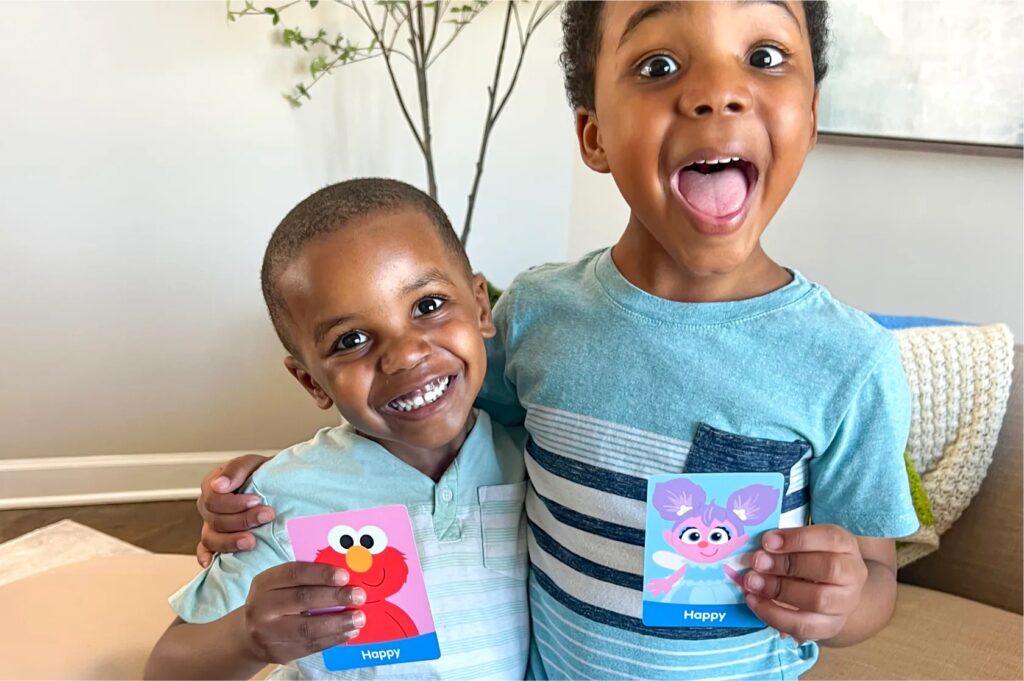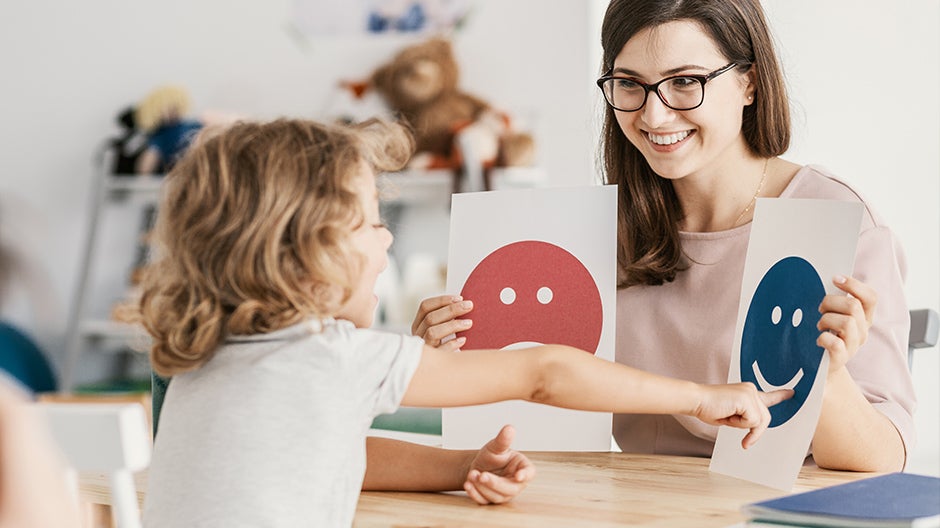When your child reads aloud, what does it sound like to you? Are they reading with expression, or are they saying everything in a monotone voice?
Young readers often sound like a robot when they read. That’s because they’re busy trying to sound out the words on the page and don’t yet have the ability to think about how they sound as they read.
As your child’s skills improve and they no longer have to think about how to decode every single word, they can start reading with expression. To help your child make the transition, here are some expert tips to try.
What Is Reading With Expression?

Reading with expression means reading aloud with feeling. It puts emotion into the words on the page so that the listener can understand the author’s intent.
When a reader’s voice is expressionless, the text sounds boring. This makes it hard for the listener to stay interested. It’s difficult to follow the storyline and pay attention when you’re unsure of how the characters feel.
Think about it this way: If you were to read a suspenseful scene from a mystery novel in a monotone voice, how would it sound? Would you be interested in hearing more? Probably not. Emotions are what draw us in and make us want to hear more.
When you read with expression, you use your voice to show the emotions in the story. For example, you raise your voice when someone is scared and lower it when someone is sad. You can also use inflection and pause for effect.
Why Is Expressive Reading Important?
Reading with expression sounds better, but that’s not the only benefit. Expressive reading is essential for comprehension.
When children read with feeling, they tend to pay closer attention to the words on the page. This helps them understand the story better.
Reading with expression also helps with fluency. Using appropriate vocal inflection allows children to read faster and smoother, which helps prevent tripping on words or losing their place.
Expressive reading makes children better readers overall, too. They better understand the stories they’re reading and can share those stories with others in a way that’s interesting and enjoyable.
Additionally, good readers read with expression internally as well as externally. This is one way we get “lost” in a book, appreciate the plot, and understand the characters.
Strategies To Encourage Reading With Expression
Now that you know what it means to read with expression, let’s look at some of the best ways to encourage your child to do just that.
1) Model Expressive Reading

One of the best ways to encourage expressive reading is to let your child hear what good readers sound like. Read aloud to them yourself or listen to audiobooks with expressive narrators.
Use different voices to represent the various characters as you’re reading aloud. In addition, model how you use inflection and pauses for effect.
By listening to you, your child can better understand this literary concept and will start trying to mimic your expressions when they read themselves.
As you model this behavior, take some time to talk about why you’ve modulated your voice for different characters. For instance, if a character is angry, tell your child, “I’m using a loud voice because the character is mad.”
Keep in mind that, sometimes, we don’t realize what a character should sound like until we get more clues further down the page. If that happens, use the opportunity as a teaching experience.
You can say, “Oh, I read that with the wrong expression. Let me reread it.” This teaches your child that it’s OK to go back and try again.
You can also add a further explanation. For instance, say, “This character must be sad right now, and I used a cheerful voice. Let’s try it again.”
By going back and reading the passage with the appropriate tone of voice, you reinforce the idea that reading with expression is essential.
2) Practice Parrot Reading
Parrots often mimic the sounds they hear, and children do the same thing with reading. When you’re reading together, make sure you’re using expressions. Then, stop after a sentence or two and ask your child to read what you just read.
Before they take a turn reading, you might say something like, “Wow, Henry was really mad. Was my voice mad enough? Can you make him sound even madder?”
This technique helps them practice using the proper inflection and tone. Additionally, it allows them to take what they’ve learned through listening and give it a try on their own.
As they read, listen to their tone and inflection. The moment your child uses a tone that is even slightly in the right direction, stop them and say something along the lines of, “You read that perfectly! It sounded so much like the way Sally would say it.”
If they haven’t quite gotten the tone right, you can say, “That is such an interesting thing she just said. Can I try to say it the way she might have?” Then you say it and ask your child if you got it right. Give them a chance to critique you — kids love that!
3) Act Out Stories

Movies and plays aren’t performed in monotone. If they were, no one would watch them! Instead, actors and actresses use their voices to create different characters and moods.
You can do the same thing with stories you’re reading together. As you read, ask your child to act out what’s happening in the story. Have them use their voice and facial expressions to bring the story to life.
If they are struggling to get into character, offer some suggestions. For instance, “I think the character would sound scared right now,” or “The character is excited. Can you show me what that looks like?”
You can also take on a part and act with your child. That way, they can learn by watching you.
4) Read Easy Books With Expression
As mentioned earlier, young readers only have so much attention to devote to reading. If they’re too focused on sounding out words, they won’t also be able to focus on how the words sound out loud to others.
To help prevent this dilemma, choose books that your child can read with ease. This way, they won’t have to worry about decoding the words and can instead focus on reading with expression.
Don’t worry about going down in reading level as you teach this reading skill. Once they’ve mastered the skill, you can challenge them again with harder books. But, for now, let them focus on using their voice to make sense of the story.
5) Show Expressive Emotions

Reading isn’t the only time you use your voice to show how you’re feeling. All throughout the day, we use intonation and inflection to express feelings. You can use this to your advantage as you teach your child to read with expression.
Model different emotions. For instance, say something in a sad voice and then repeat it in a happy voice. Point out how the words sound different when you change the tone.
You can also ask your child how they would say something if they felt a certain way. For instance, you might ask, “How would you say ‘I’m hungry’ if you were outraged? How would it sound if you were sad?”
Pointing out emotions helps them understand how feelings influence the way we speak.
To help them better grasp this concept, play a quick game. Ask your child to listen to the words you say and try to guess how you’re feeling.
Then, use your expressive language. Let your child guess what emotion you’re experiencing. If they’re having trouble, spend some time intentionally working on social-emotional activities.
The HOMER Explore Feelings Kit is a great place to start!
6) Record Your Child
Use a recording app or tape recorder to capture your child reading aloud. It is a great way to monitor their progress and give them feedback.
First, let your child read a book or passage without stopping. Then, listen to the recording together. As you do, point out what they’re doing well and make suggestions for how they can improve.
By sharing specific praise and detailed feedback, you help your child know what to work on. Then, ask them to try it again. Finally, let them listen to both recordings and see which one had the more expressive reading.
You can even challenge them to use the opposite emotions while they read. For example, have them read a happy passage in an angry voice or a mad section in a joyful voice.
7) Play Expression Charades

Teach your child to read with expression by playing this fun game. To prepare, write a couple of simple sentences on paper. Make sure you use words that they can read.
On another piece of paper, make a list of feelings. Cut those apart so each emotion is on a small strip of paper.
Next, ask them to randomly pick a strip and quietly read what it says. Then, challenge them to read each sentence aloud, using the emotion they drew.
When they’ve finished reading, guess what emotion they drew, and then switch roles so your child has the chance to listen and guess.
Say Goodbye To Boring Reading

Once your child learns how reading with expression sounds, they’ll never want to go back to reading in a monotone voice. Mastering this skill makes reading less boring and makes it easier to follow along and understand the story.
Turn to the HOMER app for lots of great stories that are read with wonderful expression in the Read It To Me mode or, for many of the stories, you can read to your child directly from the app in the Read It Myself mode.
Here’s to reading!











